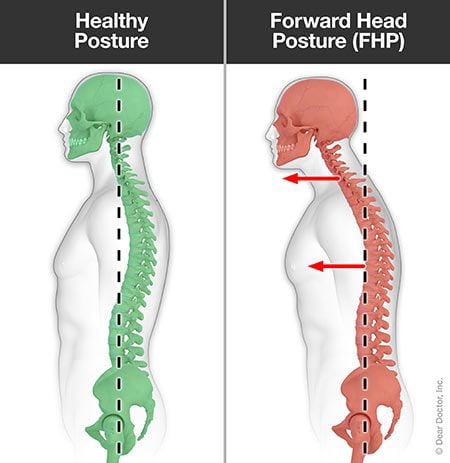
Good posture does more than make you look confident. Maintaining and practicing good posture is key in the prevention of added stress on your bones, muscles and ligaments. Posture is something chiropractors are keenly aware of because of the many ways poor posture can affect your well-being.
Forward head posture (FHP) is what it sounds like—when you carry your head in front of your shoulders instead of directly in line with your spine. It can set off a cascade of postural no-no’s that can strain your muscles and cause pain.
If you want to know if you are among the majority of adults who have forward head posture, here’s a simple test:
- Stand with your head and back against the wall.
- Place your heels against the wall.
- Put as many fingers as you can between the wall and the back of your head.
If you can fit at least three fingers between your head and the wall, then you may have forward head posture. As we look down at our computers and handheld devices, it’s easy to see how FHP can develop, but you may not know the implications for your body.
Forward Head Posture’s Domino Effect
When you move your head forward, it pulls your shoulders forward too, rounding them forward. That, in turn, pulls on your upper back, curving your spine more than it should. People end up in an abnormally hunched position with too much curvature of the thoracic spine (hyperkyphosis).
When your head is in the upright position, it keeps your neck stretched and elongated. But when your head habitually leans forward, the muscles at the base of the skull become shortened. The shortened muscles pull on the skull and can create headaches. At this point, your spinal alignment is way off kilter.
FHP can exert up to five times more force on the neck than when you carry your head correctly. Much of that stress is transferred from the cervical vertebrae to muscles that weren’t meant to support it. The pressure can trigger headaches or reduce your ability to rotate and tilt your neck.
But wait, there’s more. Many of us have more than a touch of what’s called “nomophobia,” which is an irrational fear of being without our phone. Cell phones are a weight around our neck, so to speak, since most of us spend hours each day looking down at them. That posture may affect our mood as well as our physical health. Research shows that slumping can make us feel more depressed, while good posture has positive effects. Good posture radiates confidence, even when we don't feel confident—and having good posture has been shown to actually increase our feelings of confidence, which could have an impact on our chances of success!
What is good head posture? If you think of keeping your head level and your earlobes in line with your shoulders, you’ll be on the right path.
How Chiropractors Can Help You With Forward Head Posture
Chiropractors are specially trained to understand the biomechanics of body structure and function and how these are affected by posture. If we detect forward head posture, we can adjust the cervical spine using precise, controlled movements or instruments to help bring you back into alignment. We can also recommend stretches, exercises and/or devices to help you achieve your posture goals. Once we’ve got you there, we will go over important lifestyle modifications that will keep you from sinking into FHP again.
Forward head posture can be reversed with exercise, attention and practice. Here are some exercises you can try after consulting a chiropractor so you know how to do them properly:
- Tuck and retract your chin.
- Stretch your pecs.
- Stretch your rhomboids—the back muscles that connect the shoulder blade to the spinal column.
- Try motion control exercises (MCEs), such as yoga, Pilates or tai chi.
Your chiropractor can also suggest lifestyle changes to counteract FHP, which may include the following:
- Pull your chest up when you sit.
- Keep your computer or device at eye level so that your gaze hits the top third of the screen.
- Use a chair with a headrest that allows your head to be flush against it.
- If you work sitting down, get up and stretch every 20 to 30 minutes.
- Try a cervical pillow, which supports the natural curve of the head and neck.
It will take you a while to break old habits and change longstanding postural problems like FHP. Your joints have adapted to the posture, and you’ll have to retrain them as well as your brain. Conscious awareness of your FHP will help you correct yourself until it becomes natural. Consider asking your chiropractor about FHP and how to head off pain and reduce the risk of injury.


